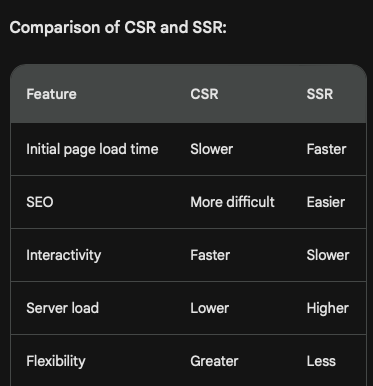Server-Side Rendering vs. Client-Side Rendering: A Comprehensive Guide
Uncover the world of Server-side vs. Client-side rendering. Dive into our comprehensive guide to boost your web application’s performance today!

Table of Contents
- Introduction
2. What is Server-Side Rendering (SSR)?
— Advantages of SSR
— Disadvantages of SSR
3. What is Client-Side Rendering (CSR)?
— How does CSR work?
— Examples of popular websites that use CSR
— Different types of CSR frameworks
4. Advantages and disadvantages of SSR
5. Advantages and disadvantages of CSR
6. When to Use SSR
— Examples
7. When to Use CSR
— Examples
8. Conclusion
Introduction

In the world of web development, server-side rendering (SSR) and client-side rendering (CSR) play a crucial role in how we experience the internet. Let’s take a journey to understand how these techniques work and why they are essential for creating engaging online experiences.
First, let’s simplify these concepts. Server-side rendering (SSR) means the server prepares web pages before showing them to you, making sure you can access the content quickly. On the other hand, client-side rendering (CSR) lets web browsers create and display content using JavaScript, making the web pages interactive and smooth.
Understanding the strengths and weaknesses of both SSR and CSR is important. SSR is great for loading pages fast and making sure search engines can find your site. CSR is perfect for creating interactive web pages without needing to reload the whole page.
In this journey, we’ll uncover how SSR and CSR work together, impacting how websites perform and keeping users engaged. Let’s explore the essence of SSR and CSR and how they shape the ever-changing world of web development.
What is Server-Side Rendering (SSR)?

Server-Side Rendering (SSR) is a technique for rendering web pages on the server before they are sent to the client. This means that the browser does not have to download and render the HTML, CSS, and JavaScript code itself. Instead, it receives a fully rendered HTML page from the server and can start displaying it immediately.
SSR offers a number of benefits
Faster initial page load times: SSR can significantly improve the initial page load time of a web application. This is because the browser does not have to wait for all of the resources to be downloaded before it can start displaying the page.
Better SEO: SSR is better for SEO than client-side rendering (CSR) because search engines can crawl and index the content of a page before it is sent to the client. This is because the content is already rendered in HTML when it is sent to the server.
Easier to implement: SSR is generally easier to implement than CSR, especially for complex applications. This is because the server is responsible for rendering the HTML, CSS, and JavaScript code, which can be difficult to do on the client side.
SSR is used by a number of popular websites, including Google Search, Facebook, Twitter, Amazon.com, and Wikipedia.
Overall, SSR is a powerful technique that can offer a number of benefits for web applications. However, it is important to weigh the benefits and drawbacks before deciding whether to use SSR for a particular application.
What is Client-Side Rendering (CSR)?

Imagine that you are going to a restaurant. With CSR, the chef would give you the ingredients and the recipe, and you would cook the meal yourself at your table. With server-side rendering (SSR), the chef would prepare the entire meal in the kitchen and then bring it to your table.
Client-side rendering (CSR) is a technique for rendering web pages on the client (browser) instead of on the server. This means that the HTML, CSS, and JavaScript code is downloaded by the browser and then executed to render the page.
How does CSR work?
When a user visits a website that uses CSR, the browser sends a request to the server for the HTML, CSS, and JavaScript code. The server sends back the code to the browser, and the browser then executes the code to render the page.
CSR frameworks, such as Angular and React, make it easy to develop CSR applications. These frameworks provide a number of features that make it easy to develop interactive and responsive web applications.
CSR can improve the performance of web applications by reducing the amount of data that needs to be transferred between the client and the server. This is because the HTML, CSS, and JavaScript code is only downloaded once, and then it can be reused to render the page multiple times.
CSR can be used to create more interactive and responsive web applications. This is because the HTML, CSS, and JavaScript code is executed on the client, which allows for faster updates to the page.
Examples of popular websites that use CSR:
- Google Search
- Facebook
- Twitter
- Netflix
- Gmail
Different types of CSR frameworks:
There are a number of different CSR frameworks available, including:
- Angular
- React
- Vue.js
- Ember.js
- Svelte
Every one of these frameworks possesses its unique set of advantages and drawbacks. Angular is a good choice for complex applications, while React is a good choice for simple applications. Vue.js is a good choice for beginners, while Ember.js is a good choice for experienced developers. Svelte is a good choice for applications where performance is critical.
CSR is a powerful technique that can be used to develop interactive, responsive, and secure web applications. However, it is important to weigh the benefits and drawbacks before deciding whether to use CSR for a particular application.
CSR is generally faster than SSR, but it can be more difficult to implement. SSR is easier to implement, but it can be slower than CSR.
Which approach is better for you depends on your specific needs. If you need a fast and interactive application, then CSR is a good choice. If you need a simple and easy-to-implement application, then SSR is a good choice.
Here is a real-world example of CSR:
When you are using Google Search, the results are rendered on your browser using React. This means that the HTML, CSS, and JavaScript code for the results is downloaded by your browser and then executed to render the results. This makes Google Search very fast and responsive.
Advantages and disadvantages of SSR
Advantages of SSR
Faster initial page load times: SSR can significantly improve the initial page load time of a web application. This is because the browser does not have to wait for all of the resources to be downloaded before it can start displaying the page.
Better SEO: SSR is better for SEO than client-side rendering (CSR) because search engines can crawl and index the content of a page before it is sent to the client. This is because the content is already rendered in HTML when it is sent to the server.
Disadvantages of SSR
Increased server load: SSR can increase the server load, especially for high-traffic websites. This is because the server has to render the HTML, CSS, and JavaScript code for each request.
Reduced interactivity: SSR can reduce the interactivity of a web application. This is because the server has to render the entire HTML page before it can be displayed to the client. This can lead to a delay when the user interacts with the page.
Advantages and disadvantages of CSR
Advantages of CSR
Faster interactivity: CSR can provide faster interactivity for web applications. This is because the browser can update the page without having to make a new request to the server.
Reduced server load: CSR can reduce server load by offloading the rendering of web pages to the browser.
Greater flexibility: CSR provides greater flexibility for developing web applications. For example, CSR can be used to create dynamic and interactive applications that would be difficult or impossible to implement with server-side rendering (SSR).
Disadvantages of CSR
Slower initial page load times: CSR can lead to slower initial page load times, especially for complex applications. This is because the browser has to download and execute all of the HTML, CSS, and JavaScript code before it can start rendering the page.
SEO challenges: CSR can make it more difficult for search engines to crawl and index web pages. This is because the content of the page may not be fully loaded and rendered when the search engine visits it.
When to Use SSR
Websites with a lot of static content and a focus on SEO: SSR is a good choice for websites with a lot of static content, such as blog posts, product pages, and landing pages. This is because SSR can improve the initial page load time of a website, which is an important factor for SEO.
Websites with a low-resource audience: SSR is also a good choice for websites with a low-resource audience, such as users on mobile devices or slow internet connections. This is because SSR can offload the rendering of web pages to the server, which can improve the performance of the website for these users.
Websites with complex user interfaces: SSR can also be used to create complex user interfaces that would be difficult or impossible to implement with CSR. For example, SSR can be used to create user interfaces that update dynamically without having to reload the page.
Examples:
- Google Search
- Wikipedia
- Amazon
- Facebook
When to Use CSR
Websites with a lot of dynamic content and a focus on user experience: CSR is a good choice for websites with a lot of dynamic content, such as social media websites, e-commerce websites, and single-page applications. This is because CSR can provide faster interactivity for these types of websites.
Websites with a high-resource audience: CSR is also a good choice for websites with a high-resource audience, such as users on desktop computers or fast internet connections. This is because CSR can reduce the server load for these websites.
Websites with offline support: CSR can also be used to create websites that support offline functionality. For example, CSR can be used to create websites that allow users to browse content even when they are not connected to the internet.
Examples:
- Gmail
- Google Maps
- Netflix
- Spotify
The best approach for a particular application will depend on its specific needs. SSR is a good choice for websites with a lot of static content and a focus on SEO. CSR is a good choice for websites with a lot of dynamic content and a focus on user experience.

Conclusion
In this blog post, we have discussed the advantages and disadvantages of server-side rendering (SSR) and client-side rendering (CSR). We have also provided guidance on when to use SSR and when to use CSR.
SSR renders web pages on the server before they are sent to the client. This can improve the initial page load time and SEO, but it can also reduce the interactivity of the page.
CSR renders web pages on the client. This can provide faster interactivity for users, but it can also lead to slower initial page load times and SEO challenges.
The best approach for a particular web application will depend on its specific needs. SSR is a good choice for websites with a lot of static content and a focus on SEO. CSR is a good choice for websites with a lot of dynamic content and a focus on user experience.
When choosing between SSR and CSR, it is important to consider the specific needs of your web application. There is no one-size-fits-all solution.
If you are unsure which approach is right for your web application, we recommend that you consult with a web development expert.
